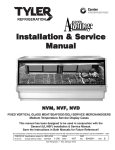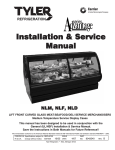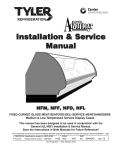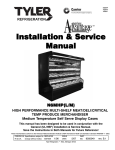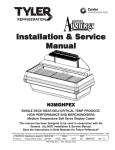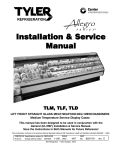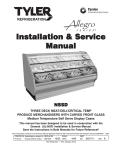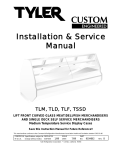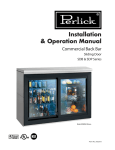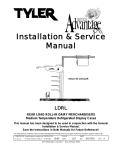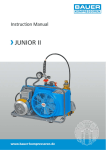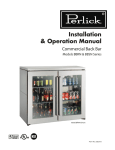Download Installation & Service Manual
Transcript
Installation & Service Manual LPFMT, LPFDT DOME-TOP SERVICE/SELF-SERVICE COMBINATION MERCHANDISERS Medium Temperature Service Display Cases This manual has been designed to be used in conjunction with the General (UL/NSF) Installation & Service Manual. Save the Instructions in Both Manuals for Future Reference! This merchandiser conforms to the American National Standard Institute & NSF International Health and Sanitation standard ANSI/NSF - 7 2003. PRINTED IN Specifications subject to REPLACES IN U.S.A. change without notice. EDITION 4/04 ISSUE DATE 7/07 Tyler Refrigeration * Niles, Michigan 49120 PART NO. 9808205 REV. C LPFMT, LPFDT CONTENTS Page Specifications LPFMT/LPFDT Specification Sheets . . . . . . . . . . . . . . . . . . . . . . . . . 4 Line Sizing Requirements . . . . . . (See General-UL/NSF I&S Manual) Pre-Installation Responsibilities . . . . . (See General-UL/NSF I&S Manual) Pre-Installation Check List . . . . . . . . . . . . . . . . . . . . . . . . . . . . . . . . . 8 Installation Procedures . . . . . . . . . . . . . . . . . . . . . . . . . . . . . . . . . . . . . . . . 8 Carpentry Procedures . . . . . . . . . . . . . . . . . . . . . . . . . . . . . . . . . . . 9 Case Line-Up . . . . . . . . . . . . . . . . . . . . . . . . . . . . . . . . . . . . . . . . . . 9 Lift Dome Glass Leveling Instructions . . . . . . . . . . . . . . . . . . . . . . . 10 Trim Installation . . . . . . . . . . . . . . . . . . . . . . . . . . . . . . . . . . . . . . . . 11 Plumbing Procedures . . . . . . . . (See General-UL/NSF I&S Manual) Refrigeration Procedures . . . . . . . . . . . . . . . . . . . . . . . . . . . . . . . 11 Temperature Control . . . . . . . . . . . . . . . . . . . . . . . . . . . . . . . . . . . . 11 Setting the Electronic Thermostat (LPFMT Top Dome) . . . . . . . . . 12 Electrical Procedures . . . . . . . . . . . . . . . . . . . . . . . . . . . . . . . . . . . 13 Electrical Considerations . . . . . . . . . . . . . . . . . . . . . . . . . . . . . . . . . 13 Case Fan Circuit . . . . . . . . . . . . . . . . . . . . . . . . . . . . . . . . . . . . . . . . 13 Fluorescent Lamp Circuit . . . . . . . . . . . . . . . . . . . . . . . . . . . . . . . . . 13 Defrost Information . . . . . . . . . . . . . . . . . . . . . . . . . . . . . . . . . . . . 13 Defrost Control Chart . . . . . . . . . . . . . . . . . . . . . . . . . . . . . . . . . . . 13 Installation Procedure Check Lists (See Gen.-UL/NSF I&S Manual) Wiring Diagrams . . . . . . . . . . . . . . . . . . . . . . . . . . . . . . . . . . . . . . . . . . . 13 LPFMT Case Circuits (6’, 8’ & 12’ Cases) . . . . . . . . . . . . . . . . . . . . 14 LPFDT Case Circuits (6’, 8’ & 12’ Cases) . . . . . . . . . . . . . . . . . . . . 16 Cleaning and Sanitation Component Removal and Installation Instructions for Cleaning Dome Top Lower Trays . . . . . . . . . . . . . . . . . . . . . . . . . . . . . . . . . . 18 Dome Top Front Air Ducts (LPFDT) . . . . . . . . . . . . . . . . . . . . . . . . . 18 Dome Top Rear Air Ducts (LPFDT) . . . . . . . . . . . . . . . . . . . . . . . . . 18 Dome Top Mullion Covers . . . . . . . . . . . . . . . . . . . . . . . . . . . . . . . . 18 Lower Shelves and Shelf Brackets . . . . . . . . . . . . . . . . . . . . . . . . . 18 Lower Bottom Trays and Screens . . . . . . . . . . . . . . . . . . . . . . . . . . .18 Lower Front Air Ducts . . . . . . . . . . . . . . . . . . . . . . . . . . . . . . . . . . . 18 Lower Rear Duct Panels (w/o Shelf Light Sockets) . . . . . . . . . . . . 18 (with Shelf Light Sockets) . . . . . . . . . . . . . . . . . . . . . . . . . . . . . . . . 18 Page 2 April, 2007 Installation & Service Manual LPFMT, LPFDT Page Lower Discharge Air Honeycomb . . . . . . . . . . . . . . . . . . . . . . . . . . 19 Lower Front Cladding . . . . . . . . . . . . . . . . . . . . . . . . . . . . . . . . . . . 19 Cleaning Instructions . . . . . . . . . . . . . . . . . . . . . . . . . . . . . . . . . . 19 Stainless Steel Cleaning Methods . . . . . . . . . . . . . . . . . . . . . . . 20 General Information Rear Sliding Door Removal and Installation . . . . . . . . . . . . . . . 22 Top Mounted Scale Shelf Installation . . . . . . . . . . . . . . . . . . . . 23 Radiant Heat Information . . . . . . . . . . . . . . . . . . . . . . . . . . . . . . . 23 Service Instructions Preventive Maintenance . . . . . . (See General-UL/NSF I&S Manual) Fan Blade & Motor Replacement . (See Gen.-UL/NSF I&S Manual) Connecting the Refrigeration Piping and Components . . . . . . . 24 Light Servicing . . . . . . . . . . . . . . . . . . . . . . . . . . . . . . . . . . . . . . . . 24 Ballast and Lighting Locations . . . . . . . . . . . . . . . . . . . . . . . . . . . . . 25 Lift-Glass Replacement . . . . . . . . . . . . . . . . . . . . . . . . . . . . . . . . . 25 Lift-Glass Gas Piston Replacement . . . . . . . . . . . . . . . . . . . . . . . 26 Lower Front Glass Replacement . . . . . . . . . . . . . . . . . . . . . . . . . 27 Parts Information Cladding and Trim Parts List . . . . . . . . . . . . . . . . . . . . . . . . . . . . . 28 Operational Parts List . . . . . . . . . . . . . . . . . . . . . . . . . . . . . . . . . . 30 TYLER Warranty . . . . . . . . . . . . . . . . . (See General-UL/NSF I&S Manual) The following Medium Temperature Lift Front Straight Glass Service/Self-Service Meat/Seafood/ Deli Combination Merchandiser models are covered in this manual: MODEL DESCRIPTION LPFMT 6’, 8’ & 12’ LIFT GLASS DOME TOP GRAVITY COIL SERVICE/SELF-SERVICE MED TEMP MEAT COMBINATION MERCHANDISERS LPFDT 6’, 8’ & 12’ LIFT GLASS DOME TOP BLOWER COIL SERVICE/SELF-SERVICE MED TEMP DELI COMBINATION MERCHANDISERS April, 2007 Page 3 LPFMT, LPFDT SPECIFICATIONS LPFMT Combination Merchandisers with Gravity/Serpentine Coil Top Dome Page 4 July, 2007 Installation & Service Manual July, 2007 LPFMT, LPFDT Page 5 LPFMT, LPFDT LPFDT Combination Merchandisers with Blower Coil Top Dome Page 6 July, 2007 Installation & Service Manual April, 2007 LPFMT, LPFDT Page 7 LPFMT, LPFDT Pre-Installation Check List WARNING These cases are very heavy and require two or more people to unload, move, position and/or install them. Improper handling of these cases could result in personal injury. NOTE: Cases with legs are shipped to stores on skids under the base frame. Cases should be unloaded and moved by one of the conventional methods INSTALLATION PROCEDURES WARNING The raised front glass does not project in front of the case, but could cause personal injury to workers, operators and/or customers. • Do not leave lift glass raised and unattended. • Know where the front edge of the raised glass is when working near it. All cases containing glass MUST be stored and installed on level surfaces to avoid possible product damage and/or glass breakage. 1. Check for hidden damage while unloading and unpacking of the case. 2. Check the “shipped loose” parts for any items; such as legs, shelves, nuts and bolts, caulking, access doors, etc. 3. Check the equipment - remove the screws used to hold down the deck pans during shipping. Remove the pans and check the following, if applicable: 4. Remove all packing material. 5. Check all flare nut connections for tightness. 6. Check all fan bracket bolts for tightness. 7. Check all electrical plug-in connections for positive seal. 8. Make sure the expansion valve feeler bulb is securely attached to the suction line. 9. All field wiring and plumbing MUST conform to national, state, and local codes. 10. Do not remove plugs (from flare nuts) or caps (from threaded connections) until the unit is ready for final hook-up. All coils are pressurized and have a Schrader Valve access fitting. If pressure has been lost, check for leaks. Page 8 This case is designed so the front glass of the top dome can be raised for cleaning and merchandising only. It is recommended that any cleaning or merchandising of the top dome be done when the store is closed. If this is not possible, it should be done at a time when customer traffic is low. The raised glass should not be left unattended and should be lowered whenever leaving the case. April, 2007 Installation & Service Manual Carpentry Procedures Case Line-Up Before starting the case line-up, review the store layout floorplans and survey the areas where case line-ups are going to be installed. WARNING • These cases are very heavy and require two or more people to move, position and/or install them. • Do not walk on the tops of these cases. Tops of cases are not designed to support the weight of a human being. Improper handling of these cases could result in personal injury. LPFMT, LPFDT NOTE Front edges of base rail and rear edges of the case legs should always be used to line-up cases. Case base rails are leveled with 6” shims, while case legs have built-in leveling adjustment capabilities. 2. Cases are shipped on skids. Using a proper lifting devise, lift case off skid and position case where it is to be installed. While the case is properly supported, install rear legs into threaded holes in base. Make sure all legs are completely threaded into the base to properly secure them. Carefully lower and position case at the highest point on the chalk line. Shim front and middle base rails to level fron posion of case. Thread out bottom rear leg inserts, up to 1 1/2”, to level the rear portion of the case. Check leveling across the top of the case, bottom front edge of dome top and on top of the front glass. CAUTION • Case must be leveled from front to back and side to side prior to joining. This insures proper operation, water drainage and glass alignment. • If the base of this case is not sitting evenly on the floor, the case could warp when loaded and possibly break the lift glass. 1. Snap chalk lines where the front base rail and the rear case legs are to be located for the entire line-up. Check level of floor where cases are to be set. Determine the highest point of the floor; cases will be set off this point. November, 2004 NOTE A foam gasket is factory installed on one end of the case. This gasket fits into a groove on the adjoining case when cases are pulled together. Do not depend on the foam gasket alone to make a good seal! Page 9 LPFMT, LPFDT Lift Dome Glass Leveling Instructions Accurate leveling is critical for the proper operation of the lift dome glass on this case. In some instances, setting the case on an apparently level floor can cause the lift glass to fit improperly. If there is any twist in the body, it could cause the lift glass not to fit or work properly. The emphasis when leveling this case must be on making sure the lift glass works and seals properly. 3. Apply two heavy beads of caulking compound from the Filler Kit to the end of case at dotted (. . .) and dashed (- - -) lines. Proper caulking provides good case refrigeration and sanitation. The case should be leveled across the top (1), close to the hinge, and on the top of the front cladding (2). A 4 foot level is recommended, and both places should be level! This will enable the lift glass to fit and work properly. 4. Push cases tightly together making sure the pull-ups are aligned. If the lift dome glass still doesn’t close or line-up properly, adjust the rear legs or shim the base rails at the corners. Leg adjustment or shimming will ensure proper operation and alignment of the lift dome glass. 5. Adjust legs or add shims under the end pedestals, as required. Check leveling at top of the case, bottom front edge of dome top and on top of the front glass. CAUTION Do not drill or use other holes through the case end for pull-ups. This may deform the case end and could cause joint leaks and/or poor refrigeration. 6. Position pull-up bolts and mounting hardware at pull-up locations (A and B). Do not tighten any pull-up hardware until all of it has been installed. Tighten all pull-up hardware equally starting at point A and finishing at point B. Do not overtighten. Page 10 The inside bottom edge of the lift dome glass must rest evenly on the glass support trim. Proper lift glass sealing is essential for good product refrigeration. NOTE Do not anchor the base to the floor or enclose the case until the lift dome glass is fitting properly and working correctly. See “General (UL/NSF) I&S Manual” for further line-up assembly instructions. April, 2007 Installation & Service Manual Trim Installation LPFMT, LPFDT Patch end trim is shipped factory installed. If field installation is required, be sure the patch end is pulled up enough to fit snuggly against the sealing tubing on the inside of the case. See “General (UL/NSF) I&S Manual” for Plumbing Procedures. Refrigeration Procedures Refrigeration system and superheat instructions can be found in the “General (UL/NSF) I&S Manual”. Service case temperature control information is listed below. Temperature Control The folowing joint trims, backers, end trims and mounting hardware are shipped loose. Trim includes: 1) Rear Top Cladding 7) Color Band Backer Joint/End Trim 8) Bumper Backer 2) Interior Dome 9) Lower Front Cladding Joint Trim Kit Joint/End Trim 3) Front Dome Duct 10) Kickplate Joint Trim Joint/End Trim 11) Horizontal 4) Upper Cladding Joint Trim Joint Trim 12) Rear Base Closeoff* 5) Rear Lower Duct 13) Lower Rear Cladding Joint Trim Joint/End Trim* 6) Front Glass 14) Upper Rear Cladding Joint Trim Joint/End Trim* The top dome section of the LPFMT case has an extra thermostat and a suction line solenoid. An additional liquid line solenoid with an on-off toggle switch isolates the top dome section on the LPFMT case. See pages 4 and 6 for case specifications. The LPFMT cases use the thermostat, extra solenoid valves and toggle switch for improved temperature control and isolation of the top dome refrigeration system. Typical LPFMT Top Dome Gravity and Serpentine Coils * Optional trim components. Horizontal joint trim covers gaps between the cases. The trim is glued onto the shipping cardboard. If trim has a notched side, apply trim with notched side towards front of case, after running beads of caulking on the edges of the cases. Sheet metal screws can be used for additional securing. July, 2007 Page 11 LPFMT, LPFDT Setting the Electronic Thermostat (LPFMT - Top Dome) 1. Remove the four screws and cover from the electronic thermostat. 2. Connect sensor wires to the common (COM) and sensor (SEN) terminals of the terminal strip located at the top left of the printed circuit board. The sensor leads are interchangeble. 7. To adjust the setpoint: a. Push the Menu Button. “SP” will flash on the LCD display. b. Push the Menu Button one more time and a setpoint temperature will be displayed. c. Push the Up or Down Button until the desired setpoint is displayed. (LPFMT - Top Dome = 20°F) d. Push the Menu Button. 8. To adjust the differential: 3. Set the Heating/Cooling jumper blocks to the “COOL” position. 4. Set the Cut-in at Setpoint/Cut-out at Setpoint jumper blocks to the “Cut-out at Setpoint” position. 5. Set the Keypad Locked/Unlocked jumper blocks to the “Unlocked” position. 6. Replace the electronic thermostat cover and secure with four screws. a. Push the Menu Button. “SP” will flash on the LCD display. b. Push the Down Button until “DIF” is shown on the LCD display. c. Push the Menu Button one more time and a differential number will be displayed. d. Push the Up or Down Button until the desired differential setting is displayed. (LPFMT - Top Dome = 9°F) d. Push the Menu Button. With the cooling mode selected, the differential is ABOVE the setpoint. The relay will be energized and the LED indicator will illuminate when the temperature reaches the differential setting. When the temperature drops to the setpoint, the relay and LED indicator will de-energize and refrigeration will stop. The settings above are specific to TYLER service cases. Other applications will require different setpoints and differentials. Page 12 April, 2007 Installation & Service Manual LPFMT, LPFDT *NOTE: Electrical Procedures Electrical Considerations CAUTION Make sure all electrical connections at components and terminal blocks are tight. This prevents burning of electrical terminals and/or premature component failure. NOTE The ballast box is located at the lower right rear corner of the case. It houses ballasts and terminal blocks. Case Fan Circuit This circuit is to be supplied by an uninterrupted, protected 120V circuit. The case fan circuit is not cycled on this case. The fan circuit consists of 2-3 fans for the LPFMT, or 4-6 fans for the LPFDT. Fluorescent Lamp Circuit Case lighting is supplied by T-8 electronic ballast lights. It is controlled by a light switch in each case. The standard lighting is 1-row of dome lights and 1-row of canopy lights. 2-rows of optional shelf lights are available. • The LPFMT has a thermostat and suction line solenoid to improve the temperature control in the top dome section. • A toggle switch with a liquid line solenoid isolates the top dome section from the lower section. WIRING DIAGRAMS ELECTRICIAN NOTE - OVERCURRENT PROTECTION 120V circuits should be protected by 15 or 20 Amp devices per the requirements noted on the cabinet nameplate or the National Electrical Code, Canadian Electrical Code - Part 1, Section 28. 208V defrost circuits employ No. 12 AWG field wire leads for field connections. On remote cases intended for end to end line-ups, bonding for ground may rely upon the pull-up bolts. The following wiring diagrams on pages 14 thru 17 will cover the LPFMT and LPFDT case, defrost and lighting circuits. Defrost Information See “General (UL/NSF) I&S Manual” for operational descriptions for Off Time defrost control. Defrost Control Chart LPFMT Defrost Option Settings Defrost Defrost Defrosts Duration Per Day (Min) Type Off Time 4 40* Term. Temp. ----- LPFDT Defrost Option Settings Defrost Defrost Defrosts Duration Per Day (Min) Type Off Time 4 40 November, 2004 Term. Temp. ----- Page 13 LPFMT Domestic & Export (50 Hz) Case Circuits (6’ and 8’ Cases) Page 14 July, 2007 LPFMT Domestic & Export (50 Hz) Case Circuits (12’ Cases) July , 2007 Page 15 LPFDT Domestic & Export (50 Hz) Case Circuits (6’ and 8’ Cases) Page 16 April, 2007 LPFDT Domestic & Export (50 Hz) Case Circuits (12’ Cases) November, 2004 Page 17 LPFMT, LPFDT CLEANING AND SANITATION Lower Shelves and Shelf Brackets Component Removal and Installation Instructions for Cleaning 1. Remove product from shelves. Dome Top Lower Trays 2. If shelf has a light, unplug the light cord from socket from the rear duct panel. Completely insert socket cover in the light socket to protect the receptacle. 1. Open the front straight glass by lifting at the bottom of the glass panel. 3. Push shelves back and then lift up and out to remove them from the shelf brackets. 2. Remove product from the case interior. 4. Remove shelf brackets from slots in rear uprights. 3. Grasp and lift out each lower tray from the bottom of the dome top. 5. After cleaning, replace in reverse order. 4. After cleaning, replace in reverse order. Lower Bottom Trays Dome Top Front Air Ducts (LPFDT) 1. Remove product from bottom of case. 1. Remove lower trays, see this page. 2. Grasp and lift each of the bottom trays from the case interior. 2. Lift out front air duct sections. 3. After cleaning, replace in reverse order. 3. After cleaning, replace bottom trays with lips down in reverse order. Dome Top Rear Air Ducts (LPFDT) Lower Front Air Ducts 1. Remove lower trays, see this page. 1. Remove bottom trays, see above. 2. Remove mounting screws from rear air duct. 2. Lift out front air duct sections. 3. Lift out rear air duct sections. 4. After cleaning, replace in reverse order. Dome Top Mullion Covers 1. Open the front straight glass by lifting the handle at the bottom. 2. Remove mounting screws from each mullion cover. WARNING Mullion covers with electrical receptacles can be cleaned without removing the electrical receptacles. Do not get moisture on electrical wires when cleaning under this cover. Moisture on wires could cause premature product failure and/or personal injury or death from electrical shock. 3. Carefully remove each mullion cover from the rear uprights. 4. After cleaning, replace and secure mullion covers in reverse order. Page 18 3. After cleaning, replace in reverse order. Lower Rear Duct Panels (w/o Shelf Light Sockets) 1. Remove shelves and bottom trays, see above. 2. Remove mounting screws and rear duct panels from case. 3. After cleaning, replace and secure rear duct panels in reverse order. (with Shelf Light Sockets) 1. Remove shelves and bottom trays, see above. 2. Remove mounting screws from rear duct panels. 3. Slowly lift out each rear duct panel until the shelf harness connector can be accessed. 4. Disconnect shelf harness connector and complete removing the rear duct panels. April, 2007 Installation & Service Manual WARNING Rear duct panels with receptacles can be cleaned without removing the electrical receptacles. Do not get moisture on electrical wires when cleaning under this cover. Moisture on wires could cause premature product failure and/or personal injury or death from electrical shock. 5. After cleaning, reconnect each shelf harness connector and replace and secure the rear duct panels in reverse order. Lower Discharge Air Honeycomb NOTE Note position of the honeycomb grid during removal so it can be reinstalled the same way. 1. Remove screws, bottom retainer plate and honeycomb grids from rear top duct. CAUTION Improper installation of the honeycomb grid could result in improper air flow and/or poor refrigeration. 2. After cleaning, replace honeycomb grid sections as they were removed and secure with the bottom retainer plate and screws. Lower Front Cladding LPFMT, LPFDT Cleaning Instructions WARNING TYLER Refrigeration does not recommend the use of high pressure cleaning equipment on service style cases!! The sealing of front glass and end joints is critical in these cases and high pressure cleaners can penetrate and/or damage these seals. Damaged seals allow water leaks and/or air leaks that can cause poor case refrigeration. CAUTION • When cleaning this case, try not to introduce water into the case faster than it can be carried away by the waste outlet. • Liquid chlorine bleach is corrosive to metals. The use of bleach or products containing bleach will damage metal surfaces and void the case warranty. • Sanitize the case with Quaternary Ammonium Solutions (ex: KAYQUAT II, J-512 Sanitizer, SANIQUAT 512, etc...) approved per 21CFR 178.1010, followed by adequate draining and air drying. These solutions may be obtained from Kay Chemical Co., Johnson Wax Professional, Coastwide Laboratories, etc.... 1. Wipe surface clean with a damp soapy cloth. • Always use a soft cloth or sponge with mild detergent and water to clean the front glass. Never use abrasives or scouring pads to clean glass. They can scratch and/or damage the glass. 2. Rinse with clean damp cloth and dry surface completely. See “General (UL/NSF) I&S Manual” for case cleaning instructions. NOTE Lower front cladding is not removable. April, 2007 Page 19 LPFMT, LPFDT Stainless Steel Cleaning Methods The cleaning data in the following stainless steel cleaning chart was supplied by AISI. The information was supplied by Prime Metals Division, Alumax Aluminum Corporation. TYPE OF CLEANING CLEANING AGENT* APPLICATION METHOD** EFFECT ON FINISH Routine cleaning Soap, ammonia or detergent and water. Sponge with cloth, then rinse with clear water and wipe dry. Satisfactory for use on all finishes. Smears and fingerprints Arcal 20, Lac-O-Nu, Lumin Wash O’Cedar Cream Polish, Stainless Shine Rub with cloth as directed on the package. Satisfactory for use on all finishes. Provides barrier film Apply with damp sponge or cloth. Satisfactory for use on all finishes. Rub with damp cloth. Satisfactory for use on all finishes if rubbing is light. Grade FFF Italian pumice, whiting or talc Rub with damp cloth. Use in direction of polish lines on No. 4 (polished) finish. May scratch No. 2 (mill) and No. 7 and 8 (polished) finishes. Liquid NuSteel Rub with dry cloth. Use a small amount of cleaner. Use in direction of polish lines on No. 4 (polished) finish. May scratch No. 2 (mill) and No. 7 and 8 (polished) finishes. Paste NuSteel or DuBois Temp Rub with dry cloth. Use a small amount of cleaner. Use in direction of polish lines on No. 4 (polished) finish. May scratch No. 2 (mill) and No. 7 and 8 (polished) finishes. Cooper’s Stainless Steel Cleaner, Revere Stainless Steel Cleaner Apply with damp sponge or. cloth. Use in direction of polish lines on No. 4 (polished) finish. May scratch No. 2 (mill) and No. 7 and 8 (polished) finishes. Stubborn spots and Allchem Concentrated stains, baked-on Cleaner splatter, and other light discolorations Samae, Twinkle, or Cameo Copper Cleaner Heat tint or heavy discoloration Page 20 Grade F Italian pumice, Steel Rub with a damp cloth. Bright, Lumin Cleaner, Zud or Restoro Use in direction of polish lines on No. 4 (polished) finish. May scratch No. 2 (mill) and No. 7 and 8 (polished) finishes. Penny-Brite or Copper-Brite Rub with a dry cloth. Use a small amount of cleaner. Use in direction of polish lines on No. 4 (polished) finish. May scratch No. 2 (mill) and No. 7 and 8 (polished) finishes. Penny-Brite or Copper-Brite Rub with a dry cloth. Use in direction of polish lines on No. 4 (polished) finish. May scratch No. 2 (mill) and No. 7 and 8 (polished) finishes. Paste NuSteel or DuBois Temp Rub with dry cloth. Use a small amount of cleaner. Use in direction of polish lines on No. 4 (polished) finish. May scratch No. 2 (mill) and No. 7 and 8 (polished) finishes. April, 2007 Installation & Service Manual LPFMT, LPFDT TYPE OF CLEANING CLEANING AGENT* APPLICATION METHOD** EFFECT ON FINISH Revere Stainless Steel Cleaner Apply with a damp sponge or cloth. Use in direction of polish lines on No. 4 (polished) finish. May scratch No. 2 (mill) and No. 7 and 8 (polished) finishes. Allen Polish, Steel Bright, Wyandotte, Bab-O or Zud Rub with a damp cloth. Use in direction of polish lines on No. 4 (polished) finish. May scratch No. 2 (mill) and No. 7 and 8 (polished) finishes. Burnt-on foods and grease, fatty acids, milkstone (where swabbing or rubbing is not practical) Easy-Off, De-Grease-It, 4-6% hot solution of such agents as trisodium tripolyphospate, or 5-15% caustic soda solution Apply generous coating. Allow to stand for 10-15 min. Repeated application may be necessary. Excellent removal, satisfactory for use on all finishes. Tenacious deposits, rusty discolorations, industrial atmospheric stains Oakite No. 33, Dilac, Texo 12, Texo N.Y., Flash-Klenz, Caddy Cleaner, Turco Scale 4368 or Permag 57. Swab and soak with clean cloth. Let stand 15 minutes or more according to directions on package. Rinse and dry. Satisfactory for use on all finishes. Hard water spots and scale Vinegar Swab or wipe with a cloth. Rinse with water and dry. Satisfactory for use on all finishes. 5% oxalic acid, 5% sulamic acid, 5-10% phospheric acid, or Dilac, Oakite No. 33, Texo 12 or Texo N.Y. Swab or soak with a cloth. Let stand 10-15 minutes. Always follow with neutralizer rinse, and dry. Satisfactory for use on all finshes. Effective on tenacious deposites or where scale has built up. Organic solvents such as carbon tetrachloride, trichlorethylene, acetone, kerosene, gasoline, benzene, alcohol and chlorethane n.u. Rub with a cloth. Organic solvents may be flammable and/or toxic. Observe all precautions against fire. Do not smoke while vapors are present. Be sure area is well ventilated. Satisfactory for use on all finishes. Grease and oil * Use of proprietary names is intended only to indicate a type of cleaner, and does not constitute an endorsement, nor is omission of any proprietary cleanser to imply its inadequacy. It should be emphasized that all products should be used in strict accordance with instructions on package. ** In all applications a sponge or fibrous brush or pad are recommended. DO NOT use ordinary steel wool, steel brushes, chlorine bleach or products containing bleach for cleaning stainless steel. April, 2007 Page 21 LPFMT, LPFDT GENERAL INFORMATION Rear Sliding Door Removal and Installation The sliding doors come installed from the factory in the door frames. These doors are removable for cleaning and to aid in case maintenance. NOTE: DO NOT FULLY IMMERSE DOORS WHEN CLEANING. The inner and outer doors are marked with labels from the factory. If the doors are not labeled, the inner door can be identified as having the limiter stops on it. 1. Remove the outer door (1) by sliding it to the right end of the door frame (2) (within an inch of being closed). 3. Tilt out the bottom of the outer door (1) so it can clear the lower track (4). 4. Lower the outer door (1) out of the upper track (3) to remove it from the case. 5. Repeat steps 1 thru 4 to remove the inner door (5). 6. Reverse the above steps to replace the inner and outer doors (5 and 1). 2. Firmly grasp both sides of the outer door (1) and lift into the upper track (3) until it clears the lower track (4). Page 22 April, 2007 Installation & Service Manual Top Mounted Scale Shelf Installation The optional scale shelf is mounted to the top center of the case and the center mullion on the back of the case. NOTE If the reinforcement is shipped loose, align with the center two holes in the bracket and attach during installation. LPFMT, LPFDT 2. Attach scale shelf (1) to top of case with three stainless steel screws (3) in the front top edge and 4 swedge bolts (4) through the reinforcement and bracket into the back of the case. NOTE Make sure the scale shelf stays level during the scale shelf support installation. 3. Install the scale shelf support (5) under the rear center of the scale shelf (1) and secure it to the rear center mullion (2) with two swedge bolts (6). (The support is not mechanically attached to the scale shelf.) Radiant Heat Information The scale shelf panel, reinforcement, and bracket should be shipped as a pre-assembled unit from the factory. Use the follow instructions to mount the scale shelf assembly. 1 3 A wide temperature range is shown for each type of lighting. This data does not show all situations. Many situations will have higher package warm-up figures than indicated. 5 6 2 4 1. Align scale shelf (1) so center of the shelf lines up with the center rear mullion (2). November, 2004 It is generally known that the temperature of displayed meat in refrigerated cases will run higher than the circulated air temperature of the cases. A dial thermometer stuck into the Page 23 LPFMT, LPFDT center of a piece of meat compared with one in the air stream quickly confirms this fact. Another fact is that the surface temperature of the meat will be higher than the center temperature due to radiant heat. TYLER’s ongoing research identifies sources of radiant heat and accurately measures and records it. These charts were developed from the information gathered during this research. Two major sources of radiant heat are from display lights and ceiling surfaces. Additional heat sources come from bad display practices which either overload the case with product or allow voids in the product display. Poor display practices impair the efficiency of the refrigeration, adding to the surface temperature of the meat. Bacteria and molds grow when surface temperatures rise above 45°F. This prematurely discolors displayed meats and causes unnecessary meat department losses. SERVICE INSTRUCTIONS Radiant Heat Measurement • Mount all refrigeration lines off the floor to allow for cleaning access. Place two accurate dial thermometers side by side in a case. Cover one of the thermometer stems with black friction tape. The temperature difference is the approximate amount of radiant heat. A change in display lighting or a reduction of high ceiling temperatures (over 80°F) could reduce the radiant heat in the case. Display Practices Encourage butchers to maintain all meat below the case load lines and to eliminate product voids. Case screens could be covered in some instances to keep the refrigerated air over the display. Connecting the Refrigeration Piping and Components WARNING Be sure to position a flame and heatresistent shield over the bottom of the case liner. Heat from brazing could damage the liner and/or cause personal injury or death from fire. 1. Remove screws and refrigeration piping cover from the left bottom of the case. 2. Position loose refrigeration piping and/or optional valves between the open lines in the bottom and upright of the case. NOTE • Make sure all sensor and thermostat wires are clear of areas being heated. 3. Apply flux to all joint ends. Starting at one end, thoroughly heat each new pipe joint and braze it together. Repeat this process until all new pipe joints have been brazed. 4. After piping has cooled, route and connect thermostat and sensor wires through openings in the bottom of the case. Light Servicing See “General (UL/NSF) I&S Manual” for preventive maintenance, T-8 lamp, fan blade and fan motor (TLD) replacement instructions replacement CAUTION The quality damage done to meat products by high temperatures and/or contamination during delivery, cooler storage, cutting and wrapping cannot be repaired by placing the products into properly operating display cases. Page 24 April, 2007 Installation & Service Manual Ballast and Lighting Locations LPFMT, LPFDT Lift-Glass Replacement WARNING Wear safety glasses and gloves and use at least two people when replacing glass. Glass is heavy and weight distribution is uneven. Mishandling of glass could cause breakage and/or personal injury. If replacing glass: All light ballasts are located in an electrcal box in the top of the rear storage cabinet at the right rear of the case. Underwriter’s Laboratory and the Canadian Standards Association, the mounting of electrical components and interconnecting wires must not deviate from the following instructions. Only qualified personnel are authorized to install the accessory items. TYLER Refrigeration recommends you order all components from its Service Parts Department. Ballast Replacement 1. Remove screws and electrical box cover from rear of case. NOTE If tappit screws are not available, a starwasher should be used between the ballast and the heads of the screws. 2. Install required number of ballasts in electrical box with two screws each. 1. Raise the old glass to the full UP position. NOTE • Glass is heavy and requires assistance for properly support. • Note positioning and installation of top edge channel before removing. 2. With assistants firmly holding both ends of the glass (1), loosen the set screws (2) in the back of the top edge channel (3) with an allen wrench or allen head screw driver. 3. Identify and connect required wiring harnesses (upper, lower, etc...) to the ballast connectors. 4. Replace electrical box cover and secure with screws. November, 2004 Page 25 LPFMT, LPFDT 3. Using a flathead screwdriver, push down aluminum wedge inside top edge channel (3), until it rests in bottom of the channel. After wedge has been released from glass (1), remove the old glass from the top edge channel. 5. Position the top edge channel (3) on the new glass panel (1) in same position as removed. NOTE Glass must be fully inserted into top edge channel before tightening. • Do not attempt to perform any work on case while piston is in compressed state. • Raise glass to full UP position before beginning any work involving gas pistons. • Do not attempt to alter a gas piston in any way. • Do not expose a gas piston to excessive heat. • Dispose of gas piston as soon as possible after removal. 6. After glass (1) is positioned in the top edge channel (3), tighten each set screw (2) until glass is held into place by the aluminum wedge. Do not overtighten. 6. With aid of assistants, lift and tentatively position new glass assembly (1) in the hinge slots. Tighten the hinge set screws (2) (7 in•lb). Do not overtighten. 7. Slowly lower glass to check position. If adjustment is necessary, raise glass and have assistants hold both ends. Loosen the hinge set screws, adjust the glass assembly position and retighten set screws to secure top edge channel in hinge slot. Do not overtighten. Lift-Glass Gas Piston Replacement WARNING The LPFMT & LPFDT cases rely upon gas pistons to assist lifting the glass and holding it in the raised position on the dome top sections. The glass is heavy and difficult for one person to lift alone while replacing a gas piston. Use an assistant to prevent possible glass breakage and/or personal injury. Each lift glass panel uses two gas pistons and two hinges to support it. Examples: 6’ & 8’ cases have 2 lift glass panels mounted on 3 support assemblies with 4 hinges and 4 gas pistons. 12’ cases have 3 lift glass panels mounted on 4 support assemblies with 6 hinges and 6 gas pistons. 1. Have an assitant lift and hold the glass in the full UP position. Note position and relationship of all glass lift components. 2. While lift glass is being held open, Loosen set screw in end of piston rod with a (size 2) allen wrench or allen head screwdriver. Carefully remove piston rod support pin while supporting the piston with your other hand. The piston will drop in your hand when the support pin is removed. Since gas pistons are very powerful when in compressed state, follow these cautions during replacement: Page 26 April, 2007 Installation & Service Manual NOTE LPFMT, LPFDT Front Lower Glass Replacement Replacement piston should be of same weight capacity as the piston being replaced. 1. Remove screw (1), screw nut (2), glass joint trim (3) and glass joint backer (4) from both joints of the broken glass. 2. Remove glass trim rail (6) from top of glass (5). 3. Install new gas piston by supporting base end with rear support pin in back of upright assembly. Rotate piston up to line up rod end in hinge and secure in place by inserting the piston rod support pin. 4. Tighten (size M4) set screw with a size 2 allen wrench or allen head screwdriver, then unscrew 1/2 turn and secure with Loctite or Weicon semi-hard. 5. Repeat steps 2 thru 4 until all bad gas pistons have been replaced. November, 2004 3. Loosen rear retainer (7) and remove broken glass from glass retainer assembly (8). 4. Apply sealant tape (9) to top and bottom edge of new glass (5). 5. Position new glass (5) in glass retainer assembly (8) and secure by tightening rear retainer (7). 6. Install glass trim rail (6) over top edge of new glass (5). 7. Install glass joint backer (4), glass joint trim (3) with screw (1) and screw nut (2) over both joint areas of the glass (5). Page 27 LPFMT, LPFDT PARTS INFORMATION Cladding and Trim Parts List Item Description 6’ 8’ 12’ 1 Rear Top Cladding, Ptd. 9805072 9803124 9803127 2 Rr. Top Cladding Joint Trim, Ptd. 9805585 9805585 9805585 3 Front Duct Joint Trim, MB 9805575 9805575 9805575 Dome Int. Joint Trim Kit, MB 9805488 9805488 9805488 4 Top Cladding, MB 9805390 9805401 9805349 5 Top Cladding Joint Trim, MB 9805572 9805572 9805572 6 Rear Lower Duct Joint Trim 5237536 5237536 5237536 7 Front Glass Joint Trim 9806330 9806330 9806330 8 Top Glass Trim Rail 9805046 9026561 9026562 9 Front Glass Retainer 9026024 9026025 9026026 Rear Glass Retainer 9805047 9026549 9026550 Color Band, Ptd. 9025979 9036805 9036806 Color Band Backer, Ptd. 9025982 9025982 9025982 10 11 Bumper ---------- color per order ---------- Bumper Backer ---------- color per order ---------- Bumper Retainer 9025052 9025058 9025061 Front Lower Cladding, Ptd. 9805057 9801525 9801526 Frt. Lwr. Clad. Joint Trim, Ptd. 9805553 9805553 9805553 Kickplate, Ptd. 9039277 9039278 9802129 Kickplate Joint Trim, Ptd. 9039020 9039020 9039020 14 Kickplate Support Assembly 9043461 9043461 9043461 15 Opt. Base End Closeoff, Ptd. (per patch end) 9803675 9803675 9803675 16 Horizontal End Trim 5964733 5964733 5964733 17 Rear Pipe Leg, Std. (1.5” X 4”) 9330018(3) 9330018(3) 9330018(4) 18 Rear Closeoff Assembly, Ptd. 9805668 9805669 9805670 19 Rear Lower Cladding, Ptd. 9805076 9803093 9803096 Rr. Lwr. Cladding Joint Trim, Ptd. 9805559 9805559 9805559 20 End Mullion Cover, Ptd. 9805083 9803115 9803115 21 Upper Rear Cladding Assy., Ptd. 9805673 9805676 9805679 22 Rr. Upr. Cladding Joint Trim, Ptd. 9805454 9805454 9805454 23 Ballast Box Cover 9803150 9803150 12 13 Page 28 9803150 April, 2007 Installation & Service Manual November, 2004 LPFMT, LPFDT Page 29 LPFMT, LPFDT Operational Parts List Case Usage Domestic Electrical Circuit 115 Volt 60 Hertz Case Size 6’ 8’ 12’ Fan Motor 5243498 9 Watt 5243498 9 Watt 5243498 9 Watt Fan Motor Brackets 5962268 5962268 5962268 Fan Bracket Plate 9041077 9041077 9041077 Fan Blades (7” 10° 5B)(LPFDT Top Dome) 9805540 9805540 9805540 5960934 5960934 5960934 Opt. ECM Fan Motor (all models) 9025002 8 Watt 9025002 8 Watt 9025002 8 Watt Opt. ECM Fan Motor Brackets 9025005 9025005 9025005 Opt. ECM Fan Blades (7” 5° 5B)(LPFDT Top Dome) 9805539 9805539 9805539 5223891 8223891 5223891 Rocker Switch 5961377 5961377 5961377 Rectangular Outlet 5236335 5236335 5236335 T-8 Lamp Ballast (top dome)(1-row) 5991029 5991029 5991030 (canopy)(1-row) 5991029 5991029 5991030 (opt. shelf)(per row) 5991029 5991029 5991030 T-8 Lampholder (top dome/canopy) 9041897 9041897 9041897 T-8 Shelf Harness 9027906 9027906 9027906 Hydro-Lift Gas Piston 9801274 9801274 9801274 Hydro-Lift Piston Tool (Required to remove pistons) 5152656 5152656 5152656 Suction Solenoid Valve (LPFMT Top Dome) 5191445 5191445 5191445 Liquid Solenoid Valve (LPFMT Top Dome) 5084991 5084991 5084991 Electronic Thermostat (LPFMT Top Dome) 9043552 9043552 9043552 Check Valve (LPFMT Top Dome) 5199417 5199417 5199417 (7” 20° 5B)(Self-Serve Sect. - All) (7” 15° 5B)(Self-Serve Sect. - All) For information on operational parts not listed above contact the TYLER Service Parts Department. Page 30 April, 2007






























